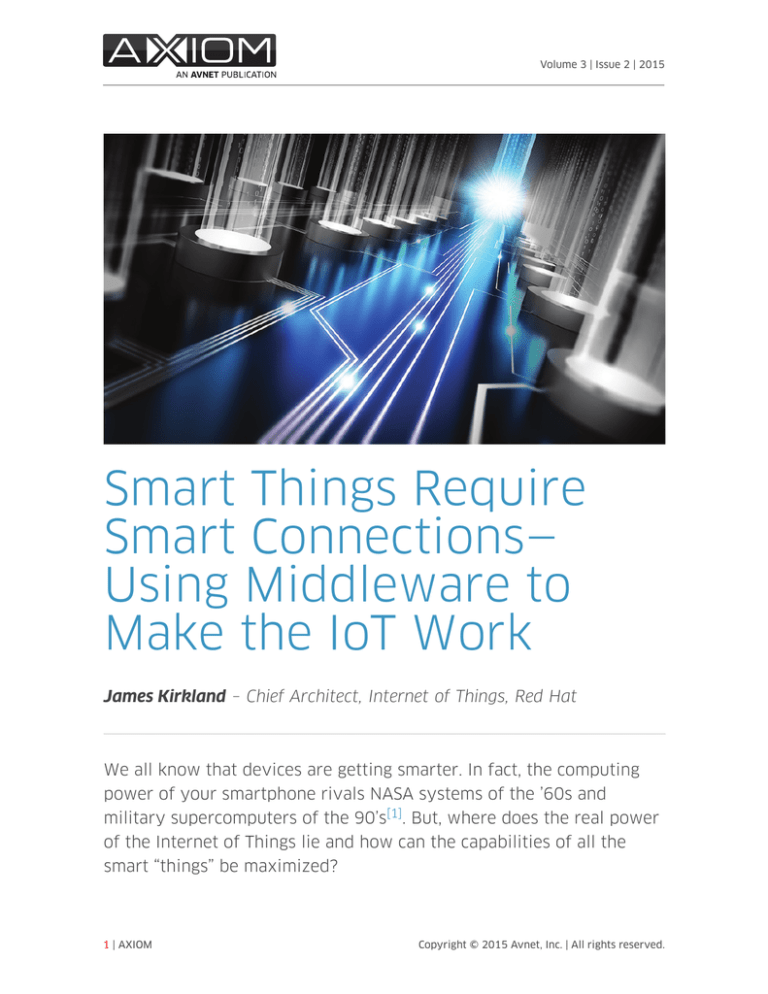
Volume 3 | Issue 2 | 2015
Smart Things Require
Smart Connections—
Using Middleware to
Make the IoT Work
James Kirkland – Chief Architect, Internet of Things, Red Hat
We all know that devices are getting smarter. In fact, the computing
power of your smartphone rivals NASA systems of the ’60s and
military supercomputers of the 90’s[1]. But, where does the real power
of the Internet of Things lie and how can the capabilities of all the
smart “things” be maximized?
1 | AXIOM
Copyright © 2015 Avnet, Inc. | All rights reserved.
Volume 3 | Issue 2 | 2015
Field level devices, previously
single purposed and one-way,
are now able to collect, send
and receive data that, in turn,
can become actionable
information for other devices.
For example, in the oil and gas
industry, a complex network of
temperature, pressure and
flow sensors embedded in devices sends data in real-time to
centralized data centers often thousands of miles away. There, the
data is aggregated, analyzed and formatted for use in control centers
where engineers monitor and observe activity in the “smart oil field”
and take action, if needed. By automating the process rather than
manually checking every well and facility, smart oil fields have
increased operational efficiency for oil companies. Additionally, the
“smart” sensors have enabled energy exploration in remote and
previously inaccessible areas. And, the data the sensors have
produced has allowed energy companies to make better – and more
profitable – decisions.
"Being able to manage edge devices without having to
“
create a separate communication network, and maintaining
security while doing so, is possible with the right
technology."
Smart sensors, fast network, big data, smart oil fields. Sounds
straightforward, right? But, with so much data, so many types of
sensors, so many different protocols and different communications
needs, getting the data to the right place, securely and in real-time
makes the difference in a successful Internet of Things
implementation.
2 | AXIOM
Copyright © 2015 Avnet, Inc. | All rights reserved.
Volume 3 | Issue 2 | 2015
Middleware plays a big role in that success, maximizing information
flow and making it possible for multi-layered communication to be
sent, processed and received. Being able to manage edge devices
without having to create a separate communication network, and
maintaining security while doing so, is possible with the right
technology. So, what’s needed to make that happen?
Pushing Data Processing to the Edge
Enterprise integration within and beyond the data center begins with
an enterprise service bus (ESB). With support for multiple protocols
such as MQTT, XMPP, JMS, etc., an ESB can drive data transformation,
handling the large volumes of data being generated at the edge of the
network, and processing summary data to send back to the data center
for deep analysis.
Data transport middleware
enables real-time messaging to
integrate applications,
endpoints and devices. It’s
important that the messaging
platform also makes it both
easy and safe for enterprise
applications to exchange
information and, at the device
tier, to be contained in a small
footprint.
Business rules middleware determines the triggers for field level
information analysis, prompting action based on pre-defined
parameters. In conjunction with real-time data caching middleware,
summary data is culled, sending streamlined data and avoiding
sending extraneous device information to the datacenter.
3 | AXIOM
Copyright © 2015 Avnet, Inc. | All rights reserved.
Volume 3 | Issue 2 | 2015
Three-Tier Architecture
For enterprise IoT implementations, we recommend a three-tier
architecture to successfully manage the information lifecycle in the
IoT. It’s at the control tier where the middleware described above is
maximized, allowing tactical data processing and analysis to occur and
action to be taken quickly. The functions that the control tier performs
differ by use case, but its job is to bring the disparate systems
together, and make the information lifecycle flow. The functions
performed might include: managing connectivity, handling data
transport, performing security measures, providing disaster recovery,
controlling processes, executing business rules and pre-processing
data. The addition of a control tier yields real benefits. Since less data
travels to the data center, transmission costs are reduced. Because
actions occur as close as possible to the edge, decision time horizons
are narrowed. The control tier helps enterprises go from data to
decision faster – and saves money along the way.
“
'…we recommend a three-tier architecture to successfully
manage the information lifecycle in the IoT.'
Enabling Business Transformation
The IoT information lifecycle can lead to transformed, efficient
business processes, the innovation of intelligent, self-aware and
customized product solutions and better customer experiences. Many
customers have discovered new revenue streams, brought products to
market faster and garnered higher profit margins. So, what’s the best
path for getting your transformation started? My advice is simple:
focus on one core business area to improve, collaborate on what you
need to create an automated, sustainable solution and then, dig in.
You’ll be surprised where the IoT journey will take you.
4 | AXIOM
Copyright © 2015 Avnet, Inc. | All rights reserved.
Volume 3 | Issue 2 | 2015
If you are interested in learning more about how Red Hat helps enable
the Internet of Things, download our whitepaper “An intelligent
system solution for the Internet of Things
(http://www.redhat.com/en/resources/intelligent-systems-solutioninternet-things), sign up for our newsletter
(https://engage.redhat.com/internet-of-things-newsletter-s201410201250) or visit us at www.redhat.com/en/insights/internetof-things (http://www.redhat.com/en/insights/internet-of-things).
[1]
Michio Kaku, Physics Of the Future: How Science Will Shape Human
Destiny and Our Daily Lives by the Year 2100
James Kirkland
James Kirkland is the Chief Architect for Red Hat Embedded
and Internet of Things (IoT) initiatives and solutions and is
the architect of Red Hat's three-tier strategy for IoT
deployments. For the past six years, Mr. Kirkland has been
focused on embedded and IoT solutions across multiple
industries including retail, transportation and energy
sectors. He has also worked on embedded and IoT projects
with multiple government agencies and contractors. A
frequent public speaker and writer on a wide range of
technical topics, Mr. Kirkland is also the co-author of Linux
Troubleshooting for System Administrators and Power
Users published by Prentice Hall PTR. He has been working
with UNIX and Linux variants over the course of 20 years
in his positions at Red Hat, and in previous roles at Racemi
and Hewlett-Packard.
TWITTER (https://twitter.com/jkirklan)
LINKEDIN (https://www.linkedin.com/company/3545)
5 | AXIOM
Copyright © 2015 Avnet, Inc. | All rights reserved.



